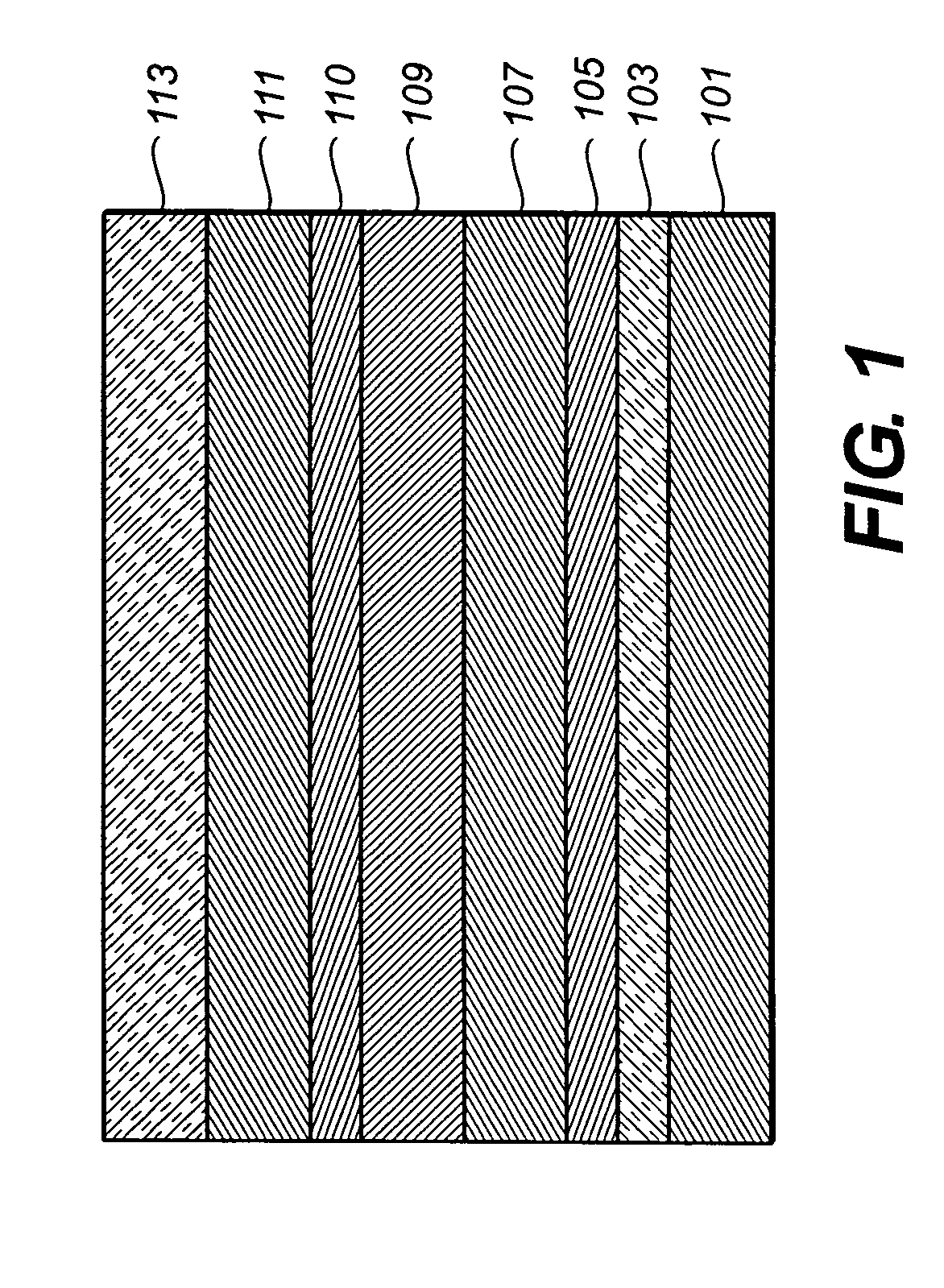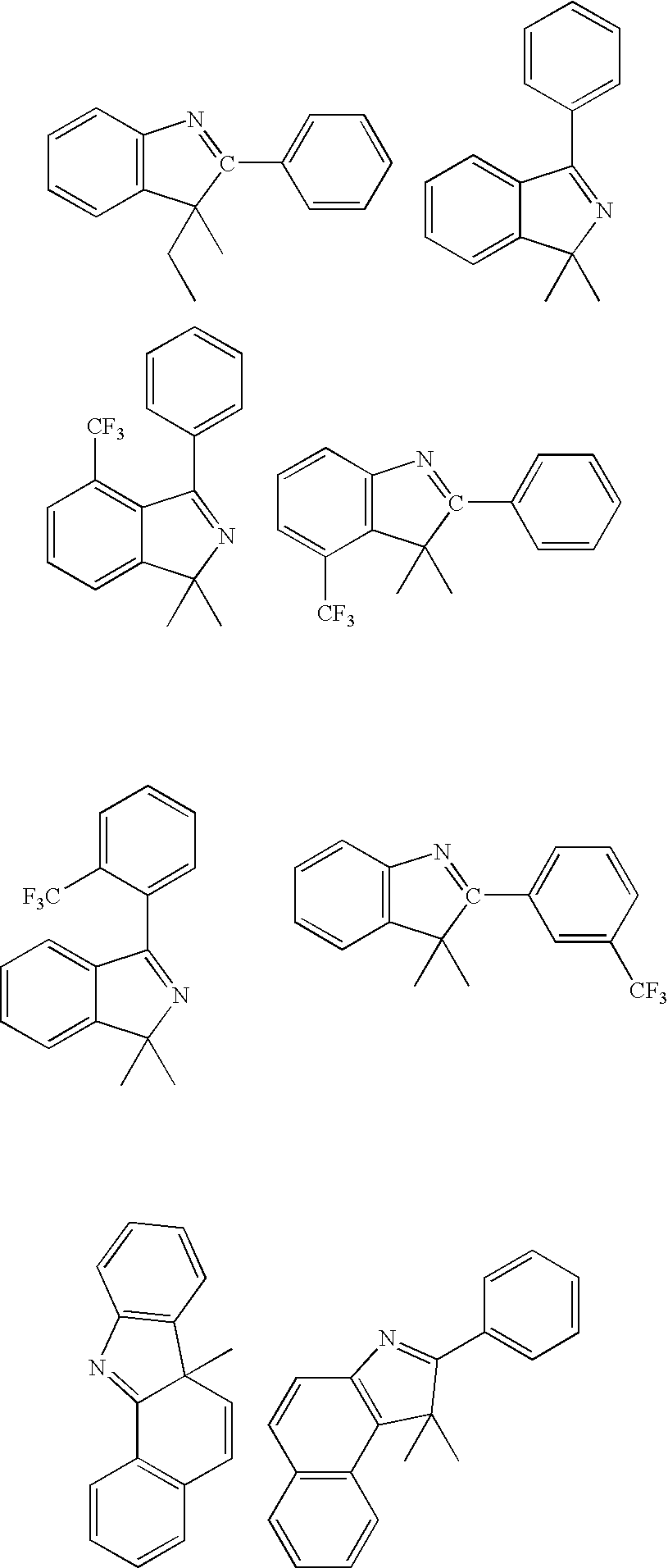Organic element for electroluminescent devices
a technology of electroluminescent devices and organic elements, which is applied in the direction of discharge tube luminescnet screens, other domestic articles, natural mineral layered products, etc., can solve the problems of large loss of efficiency and performance limitations, and hinder many desirable applications
- Summary
- Abstract
- Description
- Claims
- Application Information
AI Technical Summary
Problems solved by technology
Method used
Image
Examples
synthetic example 1
Preparation of Inv-1
[0171] The ligand, 2-phenyl-3,3-dimethylindole, was prepared by combining phenylhydrazine (180 mmol) and isobutyrophenone (180 mmol) in 100 mL toluene containing 0.5 mL acetic acid. The solution was heated at 150° C. under a Dean-Stark trap for 4 h. After removal of the toluene, the residual oil was diluted with hexane then chilled at −70° C. The phenylhydrazone was collected as a white solid, redissolved in 50 mL acetic acid, and then heated at reflux for 4 h. The reaction mixture was partitioned between ether and water, and the organic layers were combined, dried and concentrated. The resulting oil was distilled under reduced pressure to yield the 2-phenyl-3,3-dimethylindole (28.4g) as a viscous yellow oil.
[0172] K3IrBr6 (3.96 gl) and 2-phenyl-3,3-dimethylindole (3.33 g) were placed in a 125 mL flask with 36 mL 2-ethoxyethanol and 12 mL water. The mixture was freeze-thaw degassed and then refluxed under nitrogen for 4 hrs. After cooling, a deep red precipitat...
example 1
DEVICE EXAMPLE 1
[0174] An EL device (Sample 1) satisfying the requirements of the invention was constructed in the following manner: [0175] 1. A glass substrate coated with an 85 nm layer of indium-tin oxide (ITO) as the anode was sequentially ultrasonicated in a commercial detergent, rinsed in deionized water, degreased in toluene vapor and exposed to oxygen plasma for about 1 min. [0176] 2. Over the ITO was deposited a 1 nm fluorocarbon (CFx) hole-injecting layer (HIL) by plasma-assisted deposition of CHF3. [0177] 3. A hole-transporting layer (HTL)of N,N′-di-1-naphthyl-N,N′-diphenyl-4,4′-diaminobiphenyl (NPB) having a thickness of 75 nm was then evaporated from a tantalum boat. [0178] 4. A 35 nm light-emitting layer (LEL) of 4,4′-N,N′-dicarbazole-biphenyl (CBP) and Inv-1 (4% wt %) were then deposited onto the hole-transporting layer. These materials were also evaporated from tantalum boats. [0179] 5. A hole-blocking layer of bis(2-methyl-quinolinolate)(4-phenylphenolate)(A1 (Balq)...
PUM
| Property | Measurement | Unit |
|---|---|---|
| thick | aaaaa | aaaaa |
| thickness | aaaaa | aaaaa |
| work function | aaaaa | aaaaa |
Abstract
Description
Claims
Application Information
 Login to View More
Login to View More - R&D
- Intellectual Property
- Life Sciences
- Materials
- Tech Scout
- Unparalleled Data Quality
- Higher Quality Content
- 60% Fewer Hallucinations
Browse by: Latest US Patents, China's latest patents, Technical Efficacy Thesaurus, Application Domain, Technology Topic, Popular Technical Reports.
© 2025 PatSnap. All rights reserved.Legal|Privacy policy|Modern Slavery Act Transparency Statement|Sitemap|About US| Contact US: help@patsnap.com



